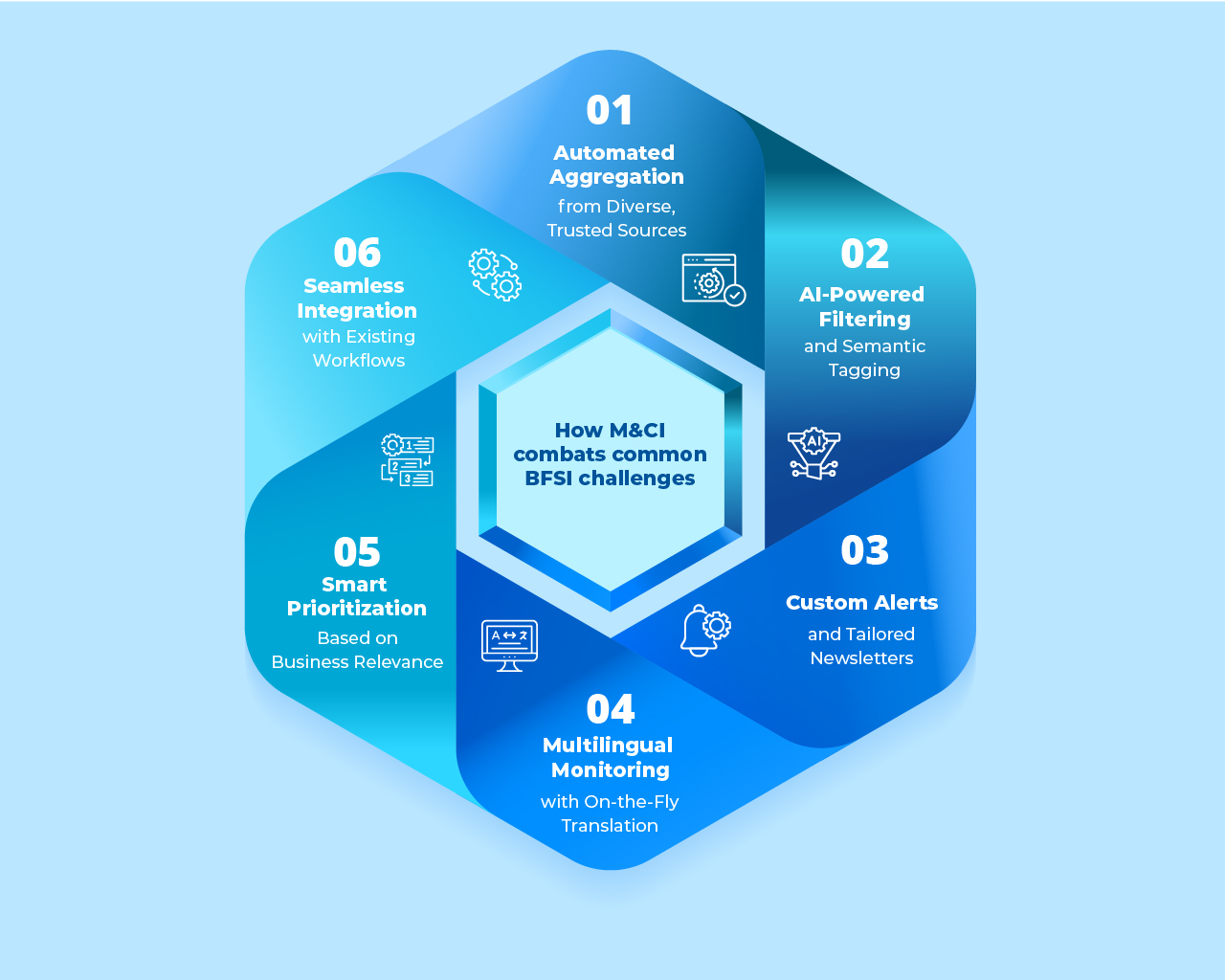Introduction
The modern BFSI sector relies heavily on complex financial infrastructure to ensure highly secure networks. Yet, it continues to face a variety of challenges. Such as, Barclays’ three-day outage, which affected millions of UK customers, highlights the vulnerabilities inherent in outdated IT systems and the pressing need for robust risk management strategies.
As regulatory landscapes change and new challenges arise, turning to risk intelligence allows BFSI organizations to make informed decisions, enhance compliance, and maintain a competitive edge.
In this blog, we will explore risk intelligence in depth, how risk and compliance teams can leverage it to anticipate regulatory changes, adapt to evolving threats, and drive sustainable success with the help of market and competitive intelligence (M&CI).
What is risk intelligence?

Risk intelligence refers to the process of gathering, analyzing, and applying information to identify potential risks, assess their business’ likelihood, and implement proactive measures to mitigate their impact. This approach enables organizations to recognize challenges that could compromise success and take steps to eliminate or minimize them.
Unlike traditional risk management, which often focuses on reactive measures, risk intelligence takes a proactive and holistic approach. It integrates diverse data sources, such as financial metrics, operational data, and external market trends to provide a comprehensive view of an organization’s risk profile.
Therefore, enabling businesses to align their risk management strategies with overall objectives, and turning potential threats into opportunities for growth.
Risk intelligence and management are crucial in the BFSI sector, enabling businesses to stay ahead of regulatory and compliance changes and technological disruptions.
The value of staying alert in the BFSI sector
BFSI companies operate in one of the most heavily regulated industries in the world. From data privacy regulations to evolving disclosure mandates, the volume and complexity of compliance requirements have grown exponentially.
Recent years have witnessed:
- The implementation of Basel III regulations for global banking institutions.
- Revised IFRS standards that affect insurance companies’ financial reporting.
- Expansion of GDPR-style data protection laws beyond the EU.
- Climate and ESG regulations from the SEC, EBA, and TCFD.
What makes this even more complex is the involvement of diverse authorities. So, if a BFSI organization operates globally, it will have to comply with dozens of overlapping or conflicting regulations.
As a result, non-compliance is not an option. Regulatory penalties can also cause a lot of damage in regard to the company’s reputation or financial situation. In 2023 alone, banks all over the world paid billions in fines, for compliance failures including poor KYC practices, breaches in data security, and more.
Such regulatory curveballs can throw off any organization, despite years of operating. In order to take action proactively, you require intelligent systems that can track regulatory shifts in near-real-time and enable organizations to adapt timely.
The real-world challenges facing risk & compliance teams
Contify’s conversations with risk leaders across BFSI institutions reveal several recurring themes. These challenges are often operational and end up impacting agility, accuracy, and strategic foresight.
1. Manual monitoring of regulatory websites
Many teams still rely on individuals to manually scan news platforms, regulatory portals, and industry websites to collect relevant risk updates. These processes are time-consuming and inconsistent, leading to missed signals or delays in identifying key developments.
One risk team described how a colleague manually logs into websites like Reuters, ECB portals, or niche local publications, pastes content into an internal system, and hopes the downstream AI models can filter relevance. This not only adds friction to workflows but introduces human bias and inconsistency in coverage.
2. Inability to scale monitoring without extra resources
With regulatory change accelerating globally, teams find themselves overwhelmed. The volume of updates across jurisdictions, languages, and topics makes it impossible to maintain complete visibility. This may also put pressure on organizations to hire new resources.
Even institutions with internal processes in place reported that expanding coverage often meant diluting focus. The lack of an intelligent system to help prioritize updates by relevance, forces teams to sift through piles of low-context inputs.
3. Fragmented access to insights across teams
Information gathered by one department often doesn’t reach others in time. Sometimes, it may not reach them at all. Risk teams may uncover crucial intelligence that never makes its way to the compliance office, digital risk leads, or CRO.
Stakeholders often express interest in solutions that would automatically tailor and route insights based on role. Such as ESG risk for sustainability leads, digital risk for IT compliance teams, etc.
4. Gaps in non-English sources
Global BFSI players need to monitor developments across a diverse linguistic and regulatory landscape. However, most tools and workflows are heavily biased toward English-language sources.
Several teams face the consequences of lacking access to non-English sources, due to issues like coverage gaps or translation delays. These blind spots can delay risk response and undermine compliance readiness.
5. No prioritization or curation of intelligence
While many tools can surface dozens or hundreds of articles per day, few can effectively prioritize what matters most. Risk teams need the top 10 updates that reflect real exposure, not an inbox full of semi-relevant noise.
Without this prioritization, intelligence becomes yet another flood of data that is more burdensome than empowering.
How M&CI helps amplify risk and compliance functions

M&CI platforms, when purpose-built for risk and compliance, can directly address the above challenges by automating, refining, and contextualizing external intelligence.
1. Automated aggregation from trusted Sources
M&CI platforms consolidate data from hundreds of thousands of sources, including regulatory sites, financial media, company filings, blogs, and social channels. This eliminates the need for manual collection and ensures no key signal goes unnoticed.
Instead of relying on analysts to scan multiple portals each morning, teams can receive compiled and deduplicated feeds within minutes, dramatically improving responsiveness.
Platforms like Contify take it a step further by sourcing information from 1mn+ vetted sources.
2. AI-powered filtering and semantic tagging
M&CI platforms rely on machine learning (ML) and NLP to understand topic relevance beyond mere keywords, which helps reduce noise. For instance, they can distinguish between “Jaguar” the company and “Jaguar” the animal, ensuring updates are contextually accurate.
These platforms also allow the creation of “semantic spaces” custom groupings of related concepts such as “digital banking regulation,” “stress testing,” or “election-related economic risk,” so results reflect the user’s true intent.
3. Custom alerts and tailored newsletters
To improve cross-functional distribution, M&CI platforms enable automated routing of insights. Some platforms also allow you to configure information separately for teams and create custom alerts and newsletters segmented by topic or recipient.
This means each stakeholder only sees what’s relevant to them, increasing engagement and decreasing overload.
Contify even allows you to create and share newsletters with non-platform users within minutes.
4. Multilingual monitoring with accurate translation
Global coverage is a growing requirement of businesses. With AI-driven translation layers, intelligence platforms can now surface and translate foreign-language insights in real time, making developments in Italy, Malaysia, or Germany just as accessible as U.S. news.
Risk teams can now track regulatory changes from regional authorities that would otherwise go unnoticed.
Some platforms like Contify let you track more than 50 languages.
5. Smart prioritization based on business relevance
Advanced ranking algorithms help surface the most critical updates first, based on criteria such as trusted sources, recency, executive mentions, and connection to key topics.
Rather than sifting through 100 updates, compliance teams can start each day with a ranked top 10, enabling better decisions, faster.
Further, you can customize daily alerts with Contify; for example, your teams would be alerted on the communication channel they already use, instead of visiting the platform every day.
6. Seamless Integration with Existing Workflows
To maximize impact, intelligence must be delivered in formats and channels that teams already use. M&CI platforms increasingly offer integrations with:
- Outlook (automated email updates)
- Microsoft Teams and Slack
- Internal knowledge management systems
- PDF, Excel, and API-based outputs
This ensures intelligence is acted upon, not ignored.
Best practices for risk and compliance teams using M&CI
To get the most from M&CI platforms, risk and compliance leaders should adopt a structured approach:
- Define Core Intelligence Objectives: Start by aligning around what matters most, cybersecurity risk, ESG, liquidity exposure, operational resilience, or third-party risk.
- Establish Cross-Team Collaboration: Bring together compliance, digital, legal, and strategic risk units to share needs and define joint intelligence goals.
- Curate watchlists and semantic topics: Work with your platform provider to define company watchlists, regulatory sources, and nuanced topic clusters to ensure relevant filtering.
- Review and tune regularly: Review feed performance and reconfigure filters or alerts as needs evolve.
- Measure and Report Impact: Track how intelligence informs decisions, such as flagging a regulatory inspection, preparing for an ESG mandate, or identifying a peer’s response to sanctions. Build KPIs to show value.
Choosing the right M&CI platform
Not all platforms are created equal. The ideal M&CI solution for BFSI risk and compliance teams should offer:
- Regulatory and industry-specific coverage
- Semantic filtering, not just keywords
- Custom alerting and stakeholder targeting
- Translation and multilingual capabilities
- Workflow integration (email, Teams, APIs)
- Prioritization and deduplication of updates
Why Contify is the right choice for BFSI risk intelligence
Contify stands out as a trusted M&CI platform designed to meet the nuanced needs of BFSI institutions. With deep expertise in regulatory intelligence, semantic enrichment, and role-based delivery, Contify helps risk and compliance teams automate the manual, reduce noise, and surface what matters most.
The platform offers:
- Coverage from over 1Mn+ global sources, including regulatory portals
- AI-powered semantic tagging to eliminate irrelevant content
- Support for multilingual monitoring with integrated translation
- Automated, curated alerts and newsletters tailored to compliance use cases
- Full integration into email, MS Teams, Slack, SharePoint, and internal systems
Whether you’re preparing for an ESG audit, scanning for digital risk incidents, or benchmarking regulatory responses from peers, Contify empowers you to anticipate threats and act with confidence.
Take the 7-day free trial and see results for yourself.
Frequently asked questions
What is risk intelligence, and how does it differ from traditional risk management?
Risk intelligence involves proactively gathering, analyzing, and applying information to identify potential risks, assess their likelihood, and implement measures to mitigate their impact. Unlike traditional risk management, which often reacts to issues after they arise, risk intelligence integrates diverse data sources to provide a comprehensive view of an organization’s risk profile.
What are the key challenges faced by BFSI risk and compliance teams today?
Risk and compliance teams are overwhelmed by the scale, complexity, and velocity of regulatory changes. They struggle with sifting through irrelevant noise to identify high-impact updates, monitoring multiple jurisdictions simultaneously, and ensuring internal stakeholders stay aligned. Additionally, fragmented intelligence sources and lack of automation often lead to inefficiencies and blind spots.
How can BFSI teams adapt to evolving regulatory landscapes?
BFSI teams need to shift from reactive compliance to proactive intelligence to keep up with evolving regulations. M&CI platforms like Contify, enable BFSI teams can anticipate new mandates, adjust internal controls accordingly, and stay ahead of enforcement deadlines, ensuring sustained compliance and strategic agility.
What is the impact of non-compliance on BFSI organizations?
Non-compliance can have severe consequences for BFSI firms, including hefty regulatory fines, reputational damage, legal actions, and loss of customer trust. Beyond immediate financial penalties, repeated violations can lead to increased scrutiny from regulators, operational disruptions, and even restrictions on business activities. In competitive markets, compliance failures can also erode investor confidence and brand equity.




